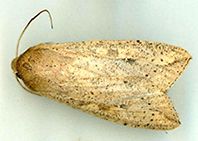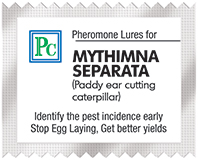
Pheromone Chemicals
Manufacturers of Pheromone Traps & Lures





Mythimna separata
(Armyworm / Ear cutting caterpillar) –It is a sporadic pest, during years of heavy rainfall. The larvae are gregarious in habit and are commonly known as armyworm.
Life cycle :
The eggs of this species are off-white. They are laid in groups low on the leaves of a food plant,
often between in the sheaths or on the blades. The mother moth uses a sticky secretion to hold
the group in place. The young Caterpillars are green. Later instars are brownish with a thin pale
dorsal line, and with dark lateral lines on each side. The head has a light and dark brown pattern.
Solitary individuals remain fairly pale in colour, but when Caterpillars become crowded, for
example when feeding communally, they develop a much darker shade. The pupa is brown, and formed
under surface litter in the soil. The adult moth has brown forewings with dark specks. The hind wings
are pale brown.
Host plants :
Host range includes Sorghum, Maize, Khabbal grass, Gram, Rice, and Sugarcane.
Mythimna separata is one of the most serious pests of cereals in Asia. It has been attacking plants
of 33 species in 8 families resulting in heavy crop losses.
Damage :
The Caterpillars feed on the leaves, leaving only the midrib uneaten.
Factors favouring insect damage:
1. Presence of many alternate hosts
2. Periods of drought followed by heavy rains
3. Dryland and wetland fields
ETL for Mythimna separata is 10–15 No’s of moths per trap per day.
Use 8-10 No’s Pheromone Traps per acre from 1 week crop stage for best results.
Trap canopy should be placed one feet above crop canopy to achieve optimum catch.
Recommended trap model :
Phero-Sensor™ - SP or Phero-Sensor™ - BP traps.
Recommended for: Sorghum, Maize, Gram, Rice and Sugarcane.
Factors favouring insect damage:
1. Presence of many alternate hosts
2. Periods of drought followed by heavy rains
3. Dryland and wetland fields
ETL for Mythimna separata is 10–15 No’s of moths per trap per day.
Use 8-10 No’s Pheromone Traps per acre from 1 week crop stage for best results.
Trap canopy should be placed one feet above crop canopy to achieve optimum catch.
Recommended trap model : Phero-Sensor™ - SP or Phero-Sensor™ - BP traps.
Recommended for: Sorghum, Maize, Gram, Rice and Sugarcane.
© 2020 Pheromone Chemicals. All Rights Reserved | Powered by: Raviteja Designs